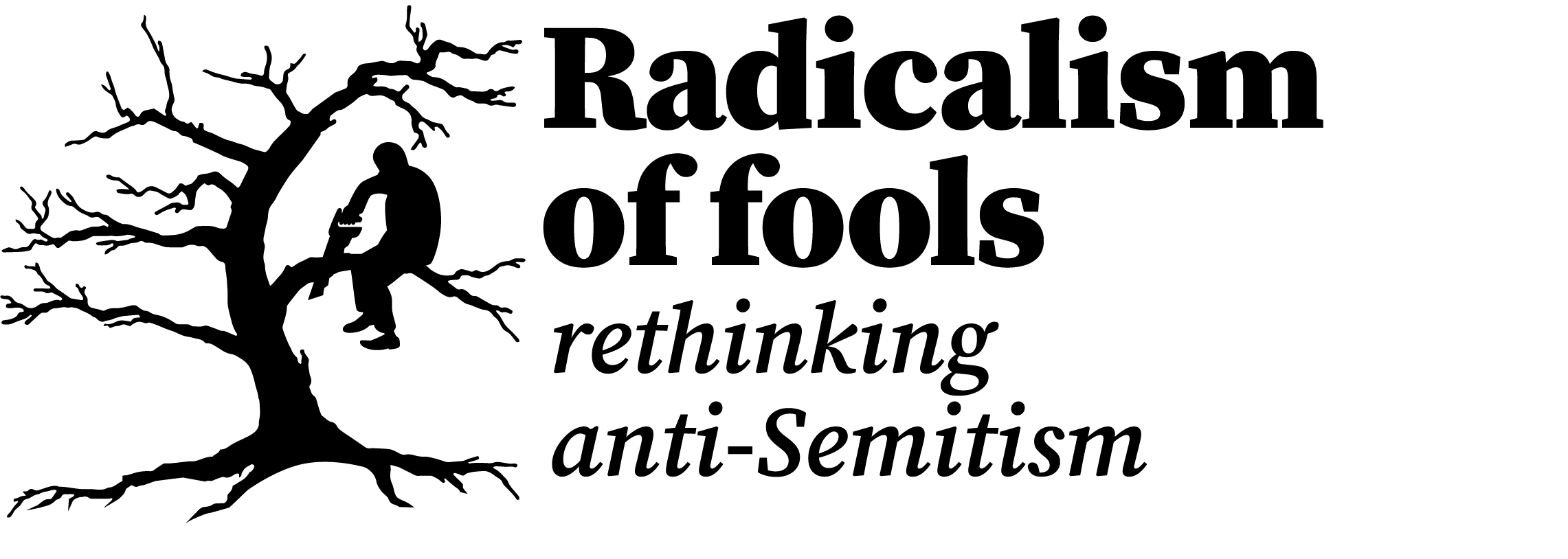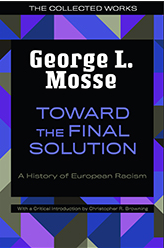This is the second in a series of pieces looking at different ways Jews have been understood. This looks at the idea of Jews as a ‘race’ whereas the previous article examined the notion of Jews as the exemplars of financial capitalism. The next piece in this series will look at the association of Jews and modernity.
One of the typical weaknesses in attempts to understand anti-Semitism is the failure to make a clear distinction between it and religious Jew hatred. Modern anti-Semitism essentially views Jews in racial terms whereas religious Jew hatred sees them as a religion. This is far from just a semantic distinction.
The exact timing varies from place to place but I would argue that Christian Jew hatred was the predominant form until the nineteenth century. One of the main charges it made against Jews was that they were collectively responsible for the killing of Christ. This notion is known as deicide. Other classic Christian anti-Jewish tropes include the blood libel - the idea that Jews killed Christian children to use their blood to make Matzot (unleavened bread). There was also the allegation that Jews were poisoning the wells to spread the Black Death and the idea of the wandering or eternal Jew. The latter morphed later into the idea of Jews as rootless cosmopolitans.
There are also anti-Jewish passages in holy Islamic texts such as the Koran and the hadith (sayings of the Prophet Muhammad). Muslim Jew hatred is not the subject of this article as the focus here is on Europe. However, it is worth noting that racialised anti-Semitism emerged slightly later in the Islamic world. Indeed imported western ideas played a key role in its development.
George Mosse’s Toward the Final Solution (1978) is one of the key texts in understanding the emergence of racism as a fully blown system of thought. It was not just about the Jews but, on the contrary, a way of understanding society more generally. His ultimate aim was to explain the tragedy of how racial thinking led to the Nazi’s “final solution to the Jewish question”. Essentially his is a study of the deep cultural background to the Holocaust Although I do not agree with all his conclusions the book provides valuable insights.
Mosse, an influential historian until his death in 1999, contends that racism emerged as the dark underside of the Enlightenment of the 17th and 18th centuries. He accepts that Enlightenment thinking had many virtues including its focus on universalism and equality. However, its preoccupation with scientific classification also gave it the impetus to sub-divide humans into different racial groups.
He also puts part of the blame on the revival of Pietism, a Protestant renewal movement, which emerged in Europe parallel to the Enlightenment. For Mosse the Pietist movement provided the myths and symbols of emerging new nations which could intertwine with the abstract ideas of the Enlightenment.
By the mid-19th century racial thinking different strands of racial thinking were being synthesised. Mosse points to Comte Arthur de Gobineau (1816-82), a French aristocrat, as a prime example of someone who pulled together elements from anthropology, linguistics and history. Towards the end of Gobineau’s life he formed a close friendship with Richard Wagner (1813-83), the composer and arch anti-Semite. Although Wagner and his circle did not invent anti-Semitism they adapted Gobineau’s ideas to blame Jews for what they saw as Germany’s national degeneration.
It should be noted in this context that racism in Britain took a different form from that on continental Europe. The Jews constituted the main minority on the European mainland. In contrast, Britain’s focus was more on black people, who constituted a large part of its empire, rather than Jews. It also concentrated much more on eugenics – improving the genetic quality of the population – rather than creating an Aryan nation.
Mosse divides early 20th century racism into two traditions. One that sought scientific respectability for its racial classification and one which relied on mystical ideas. The scientific version was the mainstream with its claims to draw on biology, statistics and zoology. In Germany it was referred to as “racial and social biology” which Mosse describes as “a doctrine of heredity and survival based upon racial eugenics” (p71).
Mystical racism was linked to the rise of a national consciousness in, particular in central Europe. In propagated racism as a form of a new national religion. Mosse traces this development to the influence of a new wave of spiritualism from America combined with increasing concern for national unity.
Hitler took on board the idea of Jews constituting an evil “principle” opposed to life itself (P89). Jews were, in his view, people without a soul cut off from nature and the universe. His was a Manichean world view – that is seeing the world in terms of a straightforward battle between good and evil – with Jews representing the physical embodiment of wickedness.
Of course Hitler built his beliefs on those of earlier generations of anti-Semites. These included Richard Wagner and his son-in-law Houston Stewart Chamberlain.
There is of course much more to the story. Toward the Final Solution is a dense book with lots of twists and turns but some key points have been outlined here. These include a valuable chapter on how Germany’s moral collapse after the first world war provided a huge fillip to anti-Semitism. It was an important stepping stone on the path to the Holocaust.
Although Mosse emphasises cultural factors in the emergence of anti-Semitism there is some room for material ones. In that respect it should be noted that part of the racial conception of Jews was to see them as closely linked to financial capitalism. Mosse notes that anti-Semites did not condemn all private property, so they were not against capitalism in an absolute sense. Instead they were opposed to the banks and the stock market as they saw these as inextricably Jewish. Anti-Semites drew the conclusion that to thwart a total Jewish takeover they had to be eliminated from national life.
Ultimately the Nazis put the extensive racial theory which had emerged, in Mosse’s view, from the eighteenth century onwards into practice. The Jews were viewed as on the side of evil in the cosmic warfare with the Aryans. This anti-Semitism had not come from one founder but a range of thinkers including Gobineau, Wagner and Chamberlain. These were all second rate thinkers but their ideas became a decisive force in Nazi Germany.
Mosse ends his book on a practical note. If the cancer of racism is to be defeated then the first necessary step is to understand it.
Although there is much that it useful in Mosse’s book I disagree on one key point. It seems to me that racial thinking only emerged in the nineteenth century rather than the eighteenth. On that point I agree with Kenan Malik that true racial thinking could only emerge with the establishment of the Enlightenment principle of equality. Race was a way of explaining how society remained unequal despite the widespread acceptance of equality as an ideal.
In this respect it is also important to note the position of Jews changed fundamentally from the late eighteenth century onwards. It was only with France’s edict of emancipation of 1791 that it began to become possible to think of Jews as equal. Before that Jews generally live at the margins of mainstream society, often confined to ghettos. Afterwards, although it was a long drawn out an uneven process, Jews came increasingly to be seen as equals.
The shift from a religious to a racial conception of Jews was a fundamental one. It was not simply a question, to use one metaphor, of a leopard changing its spots. The way the world in general was perceived was transformed as was the position of the Jews.
For that reason I reject the description of a shift in the attitudes towards Jews as chameleon changing colour. Nor do I think the idea of a mutating virus does it justice ( see video below).
Modern anti-Semitism is fundamentally different from religious Jew hatred. It is not a question of a leopard changing its spots but a whole different animal.
*The 2020 edition of Toward the Final Solution includes a valuable critical introduction by Christopher Browning, one of the leading Holocaust historians. He argues, among other things, that the anti-Jewish stereotypes of the Middle Ages had all the functional features of racism but no theory of race.
Jonathan Sacks, a former chief rabbi of Britain, outlines his view – I think mistaken – of anti-Semitism as a mutating virus.
The aftermath of the 7 October Hamas pogrom in Israel has made the rethinking of anti-Semitism a more urgent task than ever. Both the extent and character of anti-Semitism is changing. Tragically the open expression of anti-Semitic views is once again becoming respectable. It has also become clearer than ever that anti-Semitism is no longer largely confined to the far right. Woke anti-Semitism and Islamism have also become significant forces.
Under these circumstances I am keen not only to maintain this site but to extend its impact. That means raising funds.
The Radicalism of fools has three subscription levels: Free, Premium and Patron.
Free subscribers will receive all the articles on the site and links to pieces I have written for other publications. Anyone can sign up for free.
Premium subscribers will receive all the benefits available to free subscribers plus my Quarterly Report on Anti-Semitism. They will also receive a signed copy of my Letter on Liberty on Rethinking Anti-Semitism and access to an invitee-only Radicalism
of fools Facebook group. These are available for a 17% discounted annual subscription of £100 or a monthly fee of £10 (or the equivalents in other currencies).
Patron subscribers will receive the benefits of Premium subscribers plus a one-to-one meeting with Daniel. This can either be face-to-face if in London or online. This is available for a 17% discounted annual subscription of £250 or a monthly fee of £25 (or the equivalents in other currencies).
You can sign up to either of the paid levels with any credit or debit card. Just click on the “subscribe now” button below to see the available options for subscribing.
You can of course unsubscribe at any time from any of these subscriptions by clicking “unsubscribe” at the foot of each email.
If you have any comments or questions please contact me at daniel@radicalismoffools.com.

